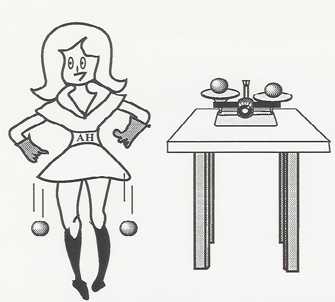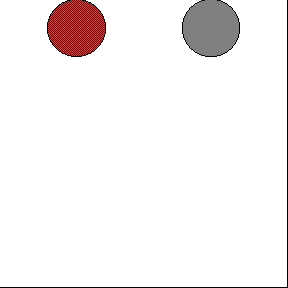- 1. Mechanics
- A. First Day Demos
- B. First Law, Inertia
- C. Second Law
- D. Third Law
- E. Angular Momentum
- F. Ballistics
- G. Center of Mass Demonstrations
- H. Energy
- I. Friction
- J. Gravitational Acceleration
- K. Kinematics
- L. Momentum and Collisions
- M. Nonlinear Mechanics
- N. Rotational Inertia
- O. Statics
- P. Torque
- Q. Uniform Circular Motion
- R. Vectors and Forces
- S. Data Studio
- 2. Harmonic Motion, Waves and Sound
- 3. Matter and Thermodynamics
- 4. Electricity and Magnetism
- 5. Light and Optics
- 6. Modern Physics
- 7. Astronomy
- 8. Software and Multimedia
- 9. Index and code conversion from older manual
- External Resources
30. Drop Two Balls
Drop a wooden ball simultaneously with a much heavier steel ball to show that they fall together. To show that the steel ball is definitely heavier, place the wooden ball in a short cup on one side of a double pan balance, and then put the steel ball in a short cup on the other side so the balance clunks down.

You might think that by this time everyone knows that a heavy object falls no faster than a light one - at least, everyone who had a high school physics course! But try asking in your Physics 10 class, "Will the heavy ball fall faster than the light ball, or the same?" You will be surprised at the variety of answers and justifications.
Then ask them about the effect of air resistance (which will probably already have come up in the discussion). To illustrate air resistance, take two sheets of paper, crumple one up into a ball, and drop them together. They have the same weight, but the flat sheet has more area "fronting the wind".
Lester Hirsch suggests a drama for jazzing up this last demonstration. Borrow the two sheets of paper from two different students. Tell them not to tear the pages out of their notebooks; you are going to return the pages. After the demonstration hand the flat sheet back to the first student, and carefully smooth out the crumpled sheet and hand it back to the second student. When he makes a face, tell the class that conversation has to start somewhere, and that he has to be one this time!
To make this demonstration somewhat more quantitative, you may wish project a slide of a wooden ball, a steel ball, and a ping-pong ball falling, photographed at 1/20 sec. intervals. (See Three Balls Falling)
As a final first-day demonstration, drop the "happy" and "unhappy" balls to show that objects that look identical may have very different physical properties.


